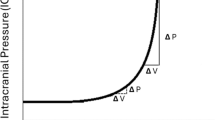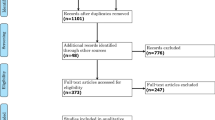Summary
The work described in this report confirms and extends the results described in a preliminary communication (Löfgren, J. and Zwetnow, N. N., Acta Neurol. Scand.46 (1970, 625) which examined the effects in cats of an expanding mass, in the form of an intracranial supratentorial balloon, on vital physiological parameters. In the present study, particular emphasis was placed on the possible significance of the rate of expansion of the mass in the range usually encountered in the clinical situation of intracranial haemorrhages.
Results from the experiments on 37 cats and 8 dogs showed that changes in vital parameters appeared when the balloon had reached a volume of about 5% of the intracranial volume (the “reaction volume”) while respiratory arrest occurred at an intracranial volume of about 10% (the “apnoea volume”). Both threshold volumes were independent of the rate of expansion within the range used.
Alterations in EEG, heart rate, respiratory rate and systemic arterial pressure usually occurred simultaneously with the development of a transtentorial pressure gradient. When respiratory arrest occurred, the cerebral perfusion pressure was markedly reduced, usually to a value of about 30 mm Hg, suggesting that brain tissue ischaemia is an important component in the lethal mechanism underlying intracranial expanding lesions.
It is proposed that the volume load tolerance of the organism towards an expanding intracranial lesion, as expressed by the reaction volume and the apnoea volume, may represent a biologically useful parameter potentially suitable for quantitative evaluation of adverse agents and therapeutic procedures.
Similar content being viewed by others
References
Aronson, S. M., Okazaki, H., Clinical neuropathological conference. Dis. Nerv. Syst.24, (1963), 247–252.
Ford, L. E., McLaurin, R. L., Mechanisms of extradural hematomas. J. Neurosurg.20 (1963), 760–769.
Hoff, J. T., Reis, D. J., Localization of regions mediating the Cushing response in CNS of cat. Arch. Neurol.23 (1970), 228–240.
Habash, A. H., Zwetnow, N. N., Ericson, K., Löfgren, J., Arterio-venous shunting in epidural bleeding. Radiological and physiological characteristics. An experimental study in dogs. Acta Neurochir. (Wien)67 (1983), 291–313.
Jennett, W. B., Stern, W. E., Tentorial herniation, the midbrain and the pupil: Experimental studies on brain compression. J. Neurosurg.17 (1960), 598–609.
Langfitt, T. W., Weinstein, J. D., Kassell, N. F., Cerebral vasomotor paralysis produced by intracranial hypertension. Neurology15 (1965), 622–641.
Langfitt, T. W., Weinstein, J. D., Kassell, N. F., Vascular factors in head injury: contribution to brain swelling and intracranial hypertension. In: Head Injury. Conference Proceedings (Caveness, W. F., Walker, A. E., eds.), pp. 172–194. Philadelphia: J. B. Lippincott 1966.
Langfitt, T. W., Weinstein, J. D., Kassell, N. F., Simeone, F. A., Transmission of increased intracranial pressure. I. Within the craniospinal axis. J. Neurosurg.21 (1964), 989–997.
Löfgren, J., Zwetnow, N. N., Tolerance of the brain to a rapidly expanding supratentorial mass. An experimental study in cats. The 22nd annual meeting for Nordisk Neurokirurgisk Förening Acta Neurol. Scand.46 (1970), 618–636.
Löfgren, J., Zwetnow, N. N., Influence of a supratentorial expanding mass on intracranial pressure-volume relationship. Acta Neurol. Scand.46 (1973), 599–612.
Löfgren, J., Zwetnow, N. N., Kinetics of arterial and venous hemorrhage in the skull cavity. Summary of paper submitted to the First International Symposium on Intracranial Pressure, Hannover, July 27–29, 1972.
Miller, J. D., Garibi, J., Intracranial volume/pressure relationship during continuous monitoring of ventricular fluid pressure. In: Intracranial Pressure I (Brock, M., Dietz, H., eds.). Berlin-Heidelberg-New York: Springer 1972.
Nakatani, S., Ommaya, A. K., A critical rate of cerebral compresion. In: Intracranial Pressure (Brock, M., Dietz, H., eds.), pp. 144–148. Berlin-Heidelberg-New York: Springer 1972.
Palvölgyi, R., Regional cerebral blood flow in tumour patients. Scand. J. Lab. and Clin. Invest. Suppl.102 (1968), XV: B.
Reichardt, M., Schädelinnenraum, Hirn und Körper. Nervenarzt35 (1964), 329–333.
Reivich, M., Regulation of the cerebral circulation. Clin. Neurosurg.16 (1969), 378–418.
Rodbard, S., Saiki, H., Mechanism of the pressor response to increased intracranial pressure. Am. J. Physiol.168 (1952), 234–244.
Schrader, H., Löfgren, J., Zwetnow, N. N., Influence of blood pressure on tolerance to an intracranial expanding mass. Acta neurol. Scand.71 (1985), 114–126.
Schrader, H., Zwetnow, N. N., Mörkrid, L., Regional cerebral blood flow and CSF pressures during Cushing response induced by a supratentorial expanding mass. Acta Neurol. Scand.71 (1985), 453–463.
Schrader, H., Löfgren, J., Zwetnow, N. N., Regional cerebral blood flow and CSF pressures during the Cushing response induced by an infratentorial expanding mass. Acta Neurol. Scand. In press.
Schrader, H., Hall, Ch., Zwetnow, N. N., Effects of prolonged supratentorial mass expansion on regional blood flow and cardiovascular parameters during the Cushing response. Acta Neurol. Scand. In press.
Sergienko, T. M., (Changes in CSF pressure during slow experimental reduction in volume of intracranial space. Problemy Neurokhirurgiu3 (1957), 265–277, cited in (Finney, L. A., Walker, A. E. eds.): Transtentorial Herniation, pp. 162. Springfield, Ill.: Ch. C Thomas 1962.
Siesjö, B., Zwetnow, N. N., Effects of increased cerebrospinal fluid pressure upon adenine nucleotides and upon lactate and pyruvate in rat brain tissue. Acta Neurol. Scand.46 (1970), 187–202.
Stern, W. E., Studies in experimental brain swelling and brain compression, J. Neurosurg.16 (1959), 676–704.
Symon, W. E., Branston, N. M., Strong, A. J., Gradation of ischaemia with threshold flow levels for tissue function and structure in the brain. In: Brain and Heart Infarct (Zülch, K. J.,et al., eds.). Berlin-Heidelberg-New York: Springer 1976.
Thompson, R. K., Malina, S., Dynamic axial brain stem distortion as a mechanism explaining the cardio-respiratory changes in increased intracranial pressure. J. Neurosurg.16 (1956), 664–657.
Zidan, A. H., Girvin, J. P., Effect on the Cushing response of different rates of expansion of a supratentorial mass. J. Neurosurg.49 (1978), 61–70.
Zwetnow, N. N., Habash, A. H., Löfgren, J., Håkanson, S., Comparative analysis of experimental epidural and subarachnoid bleeding in dogs. Acta Neurochir. (Wien)67 (1983), 67–101.
Author information
Authors and Affiliations
Additional information
This study has been supported by Norwegian Research Council for Science and the Humanities, the Norwegian Cancer Society, the Norwegian Association for Fighting Cancer, Anders Jahres Foundation for the Advancement of Science and by the Faculty of Medicine, University of Oslo, Norway.
Rights and permissions
About this article
Cite this article
Zwetnow, N.N., Schrader, H. & Löfgren, J. Effects of continuously expanding intracranial lesions on vital physiological parameters. An experimental animal study. Acta neurochir 80, 47–56 (1986). https://doi.org/10.1007/BF01809557
Issue Date:
DOI: https://doi.org/10.1007/BF01809557




